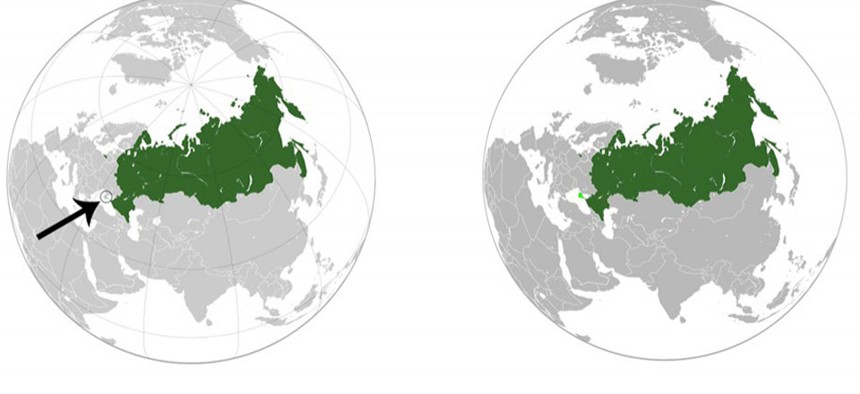Should Wikipedia Put Crimea on the Russian Map?

Wikimedia
The world's largest source of human knowledge cedes Crimea to Russia on the map, but the debate is far from over.
Above, you see two maps of Russia as supplied by Wikipedia.
The one on the left was downloaded Tuesday at 6:31 p.m. EST, nearly 12 hours after Russian President Vladimir Putin signed an annexation of the Crimean Peninsula. On this map, Crimea is not in Russia. The map on the right was accessed Wednesday morning, around 10. By then, the community of editors tending to the world's largest repository of human knowledge recognized Russia's claim to the region.
"Light green represents a claimed territory, claimed territories do not necessarily have to be territories outside of de facto control, but rather can be territories under disputed legal claims," an editor explained on a discussion board. Others argued that Crimea should appear striped on the map, to indicate outright annexation (as seen on this map of Morocco). That tension reflects the world's as it grapples with how to deal with Russia's landgrab. Is it a disputed territory, or thoroughly Russia's?
This map decision came after a bit of an editing war Tuesday, when Crimea was added and then subtracted from the map four times before the page was locked by an administrator.
Such a small detail—a shading of green—is a difficult choice for the site's editors. (On controversial topics, editors are limited to vetted Wikipedians.) As one of the top search results for both "Crimea" and "Russia," Wikipedia will provide the basis of public understanding of the region.
Traditional media have been grappling with this question, too. On Tuesday, National Geographic—a magazine so associated with maps that it publishes them as centerfolds—decided to add Crimea to Russia, though also in a special shade to designate the dispute. "We map de facto, in other words we map the world as it is, not as people would like it to be," Juan Valdés, the magazine's top mapmaker, told U.S. News & World Report.
The Crimea question on Wikipedia is far from over. The map might show Crimea in light green for now, but on both the "Russia" and "Crimea" article pages on the English Wikipedia site, the peninsula's status is described as "disputed."
On the discussion boards for these pages (where editors debate the editorial strategy of the entries) the Russian annexation of Crimea has fueled something of a philosophical debate of how Wikipedia should cover fast-changing world events.
"The biggest disappointment would be to let this article use for propaganda purposes of involved sides, USA, EU and Russia," an anonymous editor wrote on the Crimea-article discussion page.
"Such a designation has not been officially recognized yet by any major government or the United Nations," wrote a user called Daydreamer302000. "It is not in Wikipedia's charter to recognize the existence of nations."
"As of now it has been recognized by Russia," a user called Cheesenibbles retorted.
"IMO this article is/should be about the geographical area considered the Crimea, not the political lines in the sand (in the same way that the article on Kosovo is separate to the article on the Republic of Kosovo). We should however change the map to reflect that political it's no longer part of Ukraine and update the description accordingly," another user wrote.
Currently (10:20 a.m. Wednesday), the actual article text reads, "Due to recent political instability in the region and occupation by Russian military forces, national sovereignty over the peninsula is currently being disputed by Russia and Ukraine."
But that could very well have changed by now.
NEXT STORY: White House launches climate data website






